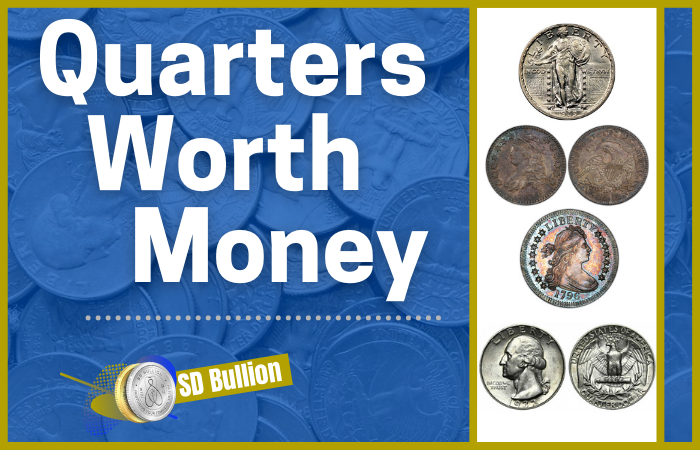Factors Affecting the 1970 Quarter Value
The Washington Quarter was introduced by the United States Mint in 1932 to commemorate the 200th anniversary of the birth of the first U.S. president, George Washington.
In this article, I provide a complete guide to exploring the design and historical significance of these coins, examining the various factors that can impact the value of a 1970 25-cent coin.
1970 Washington Quarters Price Chart
|
Type 2, Clad, MS |
Mint State-65 |
Mint State-66 |
Mint State-67 |
Mint State-68 |
Mint State-69 |
|
1970 |
$20 |
$65 |
$375 |
- |
- |
|
1970-D |
$16 |
$22 |
$50 |
$2,500 |
- |
|
1970-D DDO FS-101 (FS-027.3) |
$1,750 |
$2,500 |
- |
- |
- |
|
1970-D DDO FS-102 |
$3,000 |
- |
- |
- |
- |
|
1970-D DDR FS-801 |
$175 |
$225 |
$650 |
- |
- |
|
1970-D DDR FS-802 |
$90 |
$100 |
$400 |
- |
- |
|
Type 2, Clad, Proof Coins |
PR-65 |
PR-66 |
PR-67 |
PR-68 |
PR-69 |
|
1970-S Proof |
$6 |
$6 |
$7 |
$8 |
$14 |
|
1970-S Cameo Proof |
$10 |
$12 |
$15 |
$16 |
$42 |
|
1970-S Deep Cameo Proof |
$10 |
$16 |
$54 |
$90 |
$450 |
Key Takeaways
-
Though fairly common in low Mint State grades, the 1970 Washington Quarter becomes increasingly scarce in Superb Gem condition.
-
PCGS accounts for only four specimens minted at the Philadelphia Mint and graded MS67+, with an average price of $2,750. Denver issues are considerably more common. The highest-graded specimen is an MS68+ coin, evaluated at $10,000.
-
Aspects such as grading and varieties greatly influence the value of Washington quarters. The most prized are those with rare errors, for example, the 1970-S Washington Quarter struck on a 1941 Canadian quarter, which can bring up to $40,000.
Condition of the Coin Grading
In numismatics, coins are graded using the Sheldon Scale, which goes from 1 to 70. In this system, the coins are divided into circulated conditions (1-poor condition, 40-Extremely Fine, 50-About Uncirculated) and Uncirculated or Mint State (from 60 to 70).


The condition or grade of a coin reflects its wear and preservation state. Coins in better condition, especially those with minimal wear or uncirculated status, are more valuable than their average-condition counterparts thanks to their aesthetic appeal and scarcity.
Mint Mark and Rarity
The mint mark, in turn, indicates which facility of the US Mint produced the coin:
D is for Denver Mint, S is for San Francisco Mint, and P is for Philadelphia. A coin without a mint mark means it was also minted in Philadelphia. The 1970 business strikes of Washington quarters do not bear the S mint mark, as only proof versions of the series were produced at that mint.
According to PCGS, of the 136,420,000 Philadelphia-minted 1970 Washington Quarters, an estimated 1,227,780 have survived in MS65 or better condition. The Denver issue, with a mintage of 417,341,364, is estimated to have approximately 7,512,144 survivors in MS65 or better.
For instance, coins from smaller production runs often have fewer surviving examples, which significantly boosts their value among collectors.
This is evident when comparing the current Philadelphia issue, graded MS67+, valued at approximately $2,700, with the much rarer Denver coin, graded MS69, which sold for $15,000 on eBay in recent sales (2023). The dramatic price gap illustrates how scarcity directly translates into higher market value.
Check out our list of the most valuable quarters here
Historical Significance
Coins with historical significance, such as those commemorating important events or featuring notable designs, are often more valuable.
Collectors are drawn to pieces that reflect national pride, commemorate historic moments, or feature iconic imagery (such as an eagle, a liberty figure, or a landmark). These associations make the coin more desirable because owning it feels like holding a tangible piece of cultural identity or history.
The American Eagle and Canadian Maple Leaf bullion coins are great examples of that.
Design
The coin's iconic design plays a crucial role in its value since it represents the country's first president and the national animal, the bald eagle.
The obverse of the coin showcases a left-facing profile of George Washington, the first President of the United States, designed by John Flanagan. Washington is depicted with the word "LIBERTY" inscribed above his head and the motto "IN GOD WE TRUST" to his left. Below Washington's portrait is the year of issue, "1970."
The reverse of the coin features an image of a heraldic eagle with spread wings, perched on a bundle of arrows with two olive branches beneath it, symbolizing readiness for war yet a desire for peace. Above the eagle is the inscription "UNITED STATES OF AMERICA," and below it is the denomination "QUARTER DOLLAR."
The phrase "E PLURIBUS UNUM," meaning "Out of many, one," is inscribed between the eagle and the denomination, emphasizing the unity of the states.
Composition of the Coin
The composition, particularly of precious metals like silver or gold, directly affects a coin's intrinsic value.
A higher content of precious metals typically increases the coin's melt value beyond its face value, especially in times of high metal prices.
In 1970, however, the Washington quarters no longer contained silver. Weighing 5.67 grams, the 1970 Washington Quarter is composed of 75% copper and 25% nickel, layered over a pure copper core.
The copper and nickel composition adds minimal intrinsic value; however, this does not diminish the coin's overall desirability, which is primarily driven by its historical significance, scarcity in high grades, and error rarities.
We gathered information about all quarters and their weight in our article here
Notable 1970 Quarter Variations and Errors
The Washington Quarter series includes a variety of error coins that range widely in coin values, from just a few dollars to several hundred, depending on rarity and demand.
I prepared a special list with all the most outstanding coins found in the series.
These collectible coins feature different types of errors, such as double strikes and die clashes, making them especially appealing to collectors interested in both affordability and unique variations.
1970 No Mint Mark Quarter (Regular Strike)
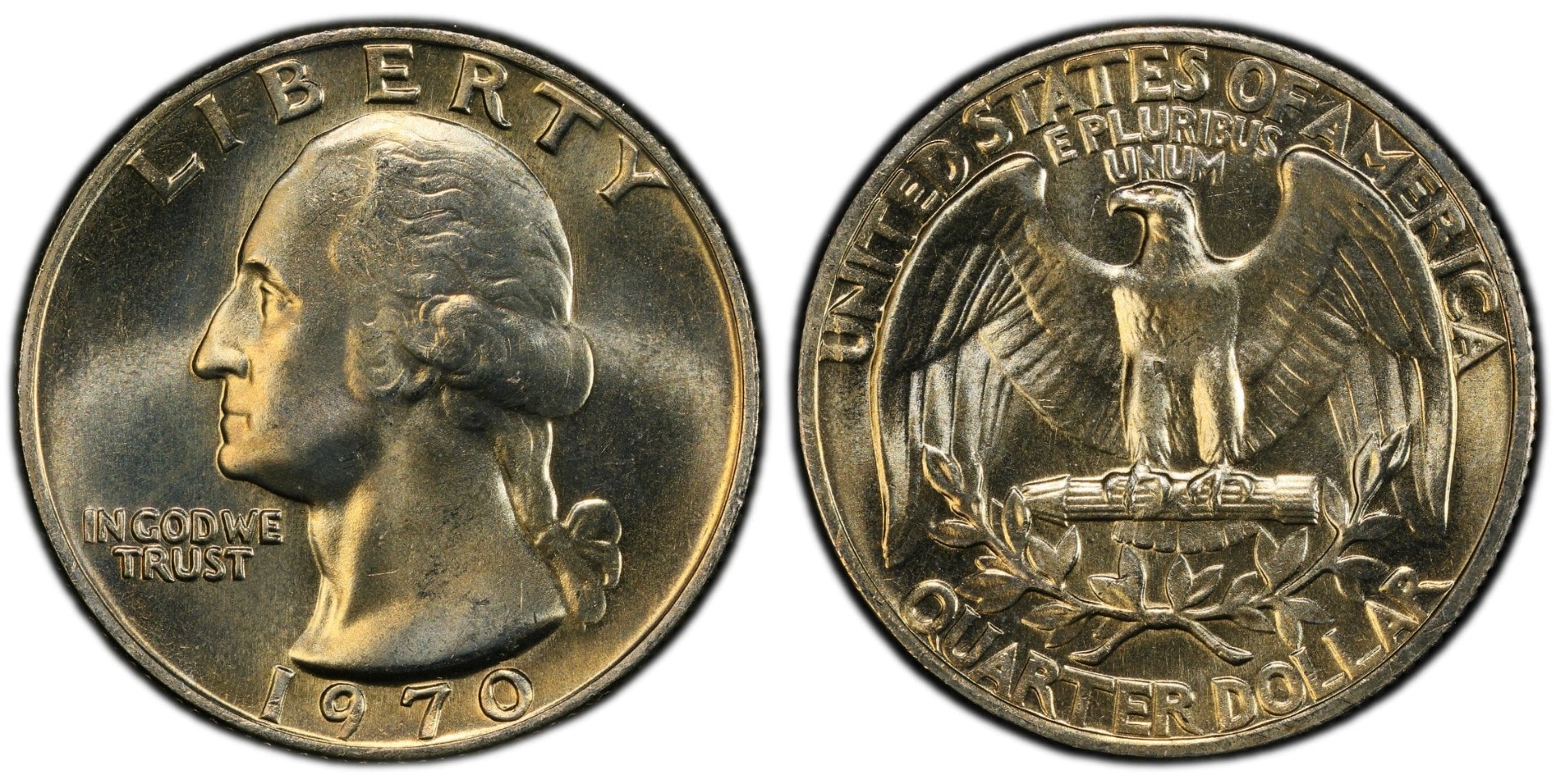
The 1970 Philadelphia Washington Quarter dollars are relatively common up to an MS66 grade, making them accessible for most collectors. However, they become much scarcer at MS67. Achieving an MS68 grade or higher is extremely challenging, as very few examples exist in such exceptional conditions.
The auction record for an MS67+ grade 1970 Washington Quarter is $2,160, set in 2019 at Heritage Auctions.
1970-D 25C (Regular Strike)

According to PCGS, the Denver issue's mintage was 417,341,364, and there are an estimated 7,512,144 survivors in MS65 or better, indicating relative rarity. Circulation coins are stored in large bins and canvas bags, which can cause bumps and bruises, making an MS70 grade nearly impossible.
With only one graded MS68+, finding this exemplar in circulation is nearly impossible. Your best chance is through coin dealers.
The auction record for a 1970-D Washington Quarter, graded MS69, was set in 2023 when an exemplar was sold for $15,000 on eBay.
1970-S 25C (Proof Coins)
The coins designated Cameo (CAM) are those with light to moderate frosted devices on both sides.
The Deep Cameo (DCAM), in turn, are proofs with deep, even frosted devices on both sides

Unlike the other coins, the 1970-S Proof Washington Quarter is relatively common in grades up to about PR69 for non-Deep Cameo surfaces.
However, it becomes scarce in PR67 Deep Cameo and even rarer in PR68 Deep Cameo, with fewer than a couple of hundred known examples.
The Cameo (or CAM) is a proof coin with sharp details, mirror-like fields, and light to moderate frosted devices on both sides. Both sides must show frosted devices to qualify, and the Deep Cameo (DCAM) is a Proof finish with mirror-like fields and deep, even frosted devices on both sides.
Finding one in PR69 Deep Cameo is particularly challenging, with likely no more than 100 examples in existence.
The auction record for a PR69 1970-S Proof Washington Quarter denominated Deep Cameo was set at $2,760 in 2007, at Heritage Auctions.
1970-D Double Die Obverse FS-101, FS-102 25C

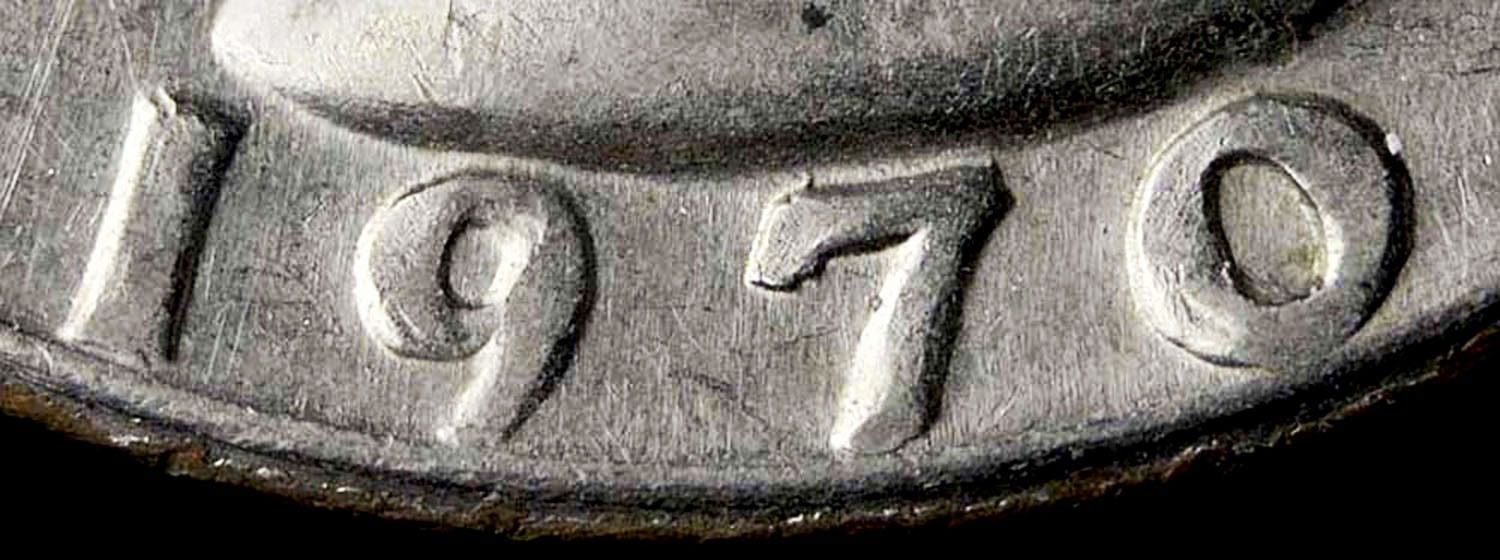
"Doubled die," also known as hub doubling, is a numismatic term that refers to the duplication of design elements on working dies. This duplication happens due to a misalignment between the die and the hub during the hubbing process.
On FS-101, Strong doubling is seen on the date, and on the inscriptions IN GOD WE TRUST and LIBERTY. On FS-102, Doubling is seen on all lettering and the date.
Heritage Auctions set an auction record of $2,875 for an MS65 FS-102 coin in 2012.
In Gem Uncirculated condition (MS66), an FS-101 can fetch $2,500.
1970-D Double Die Reverse FS-801 and FS-802 25C
This variety is designated as DDR because the doubling occurs on the reverse side. Check below:
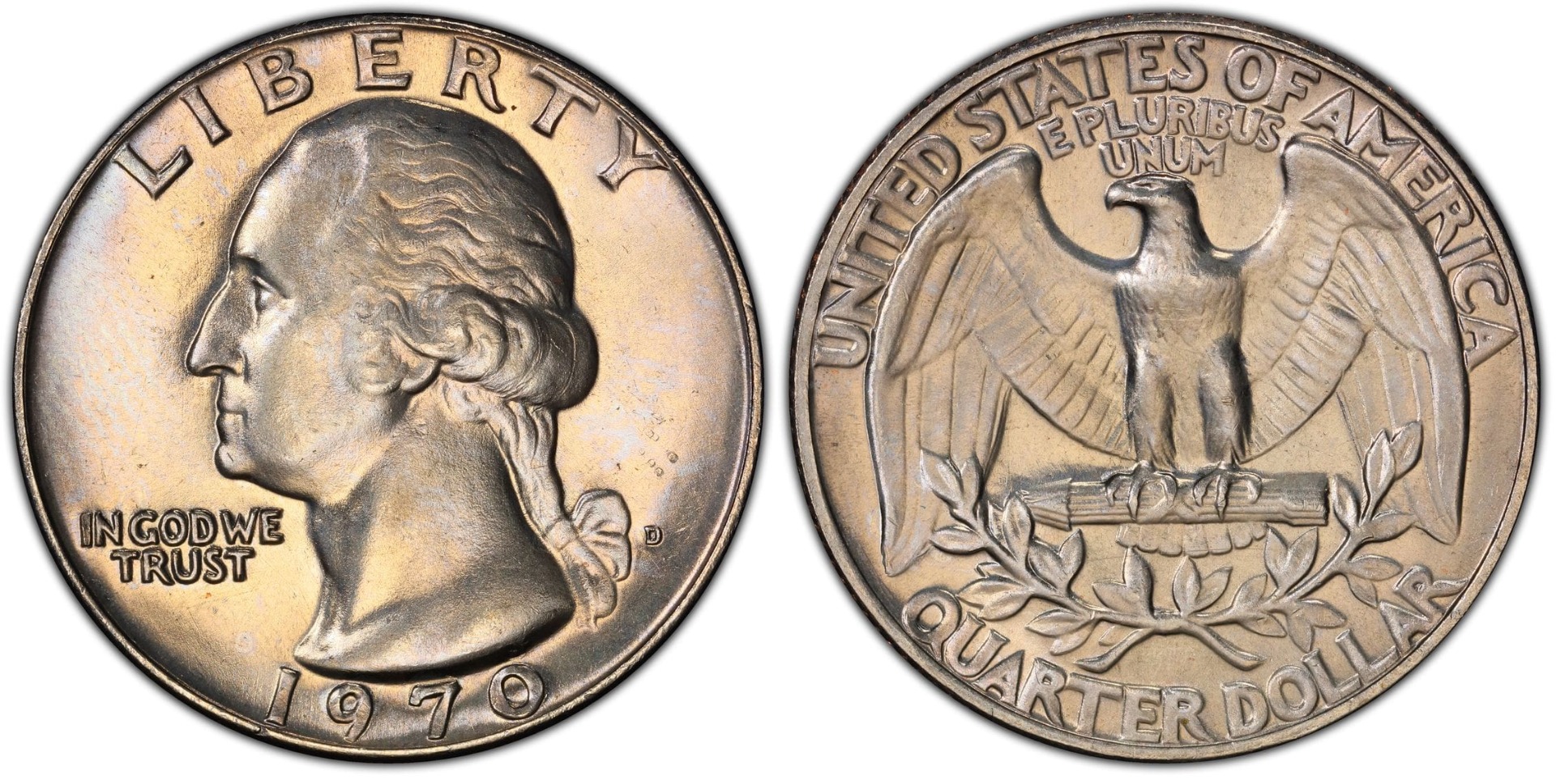
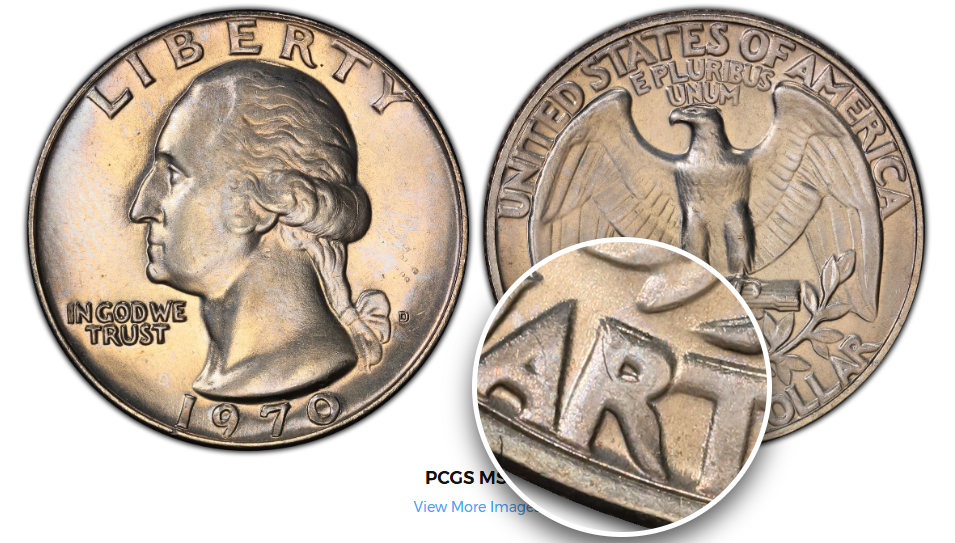
On the FS-801, Minor doubling is seen in the denomination QUARTER DOLLAR and the lower leaves over the olive branch. On the FS-802, Doubling is seen on the UNITED STATES OF AMERICA and QUARTER DOLLAR.
The auction record for an MS63 coin type FS-801 was $2,640 in 2014 at Great Collections. For its FS-802 counterpart, the auction record for an MS66 coin was $1,540 in 2014, also at Great Collections.
1970-D TYPE H Reverse 25C
This die was taken from the hub intended for proof strikes, and this variety is rare on (non-proof) circulation strike coins.
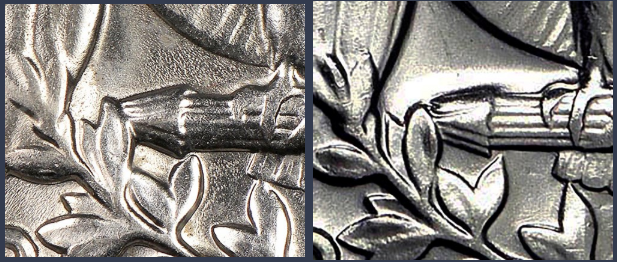
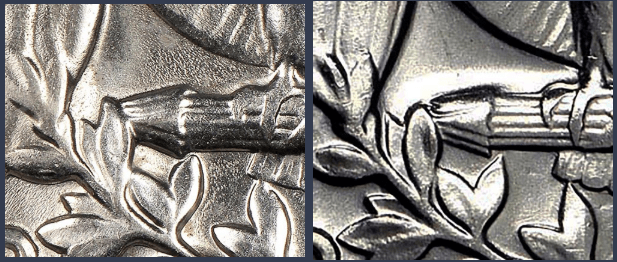
This is one of the errors that even a professional would need magnifying glasses to see.
Note that the reverse side is more pronounced, easily identified by the arrowheads being nearly embedded within the leaf, with the leaf extending above the arrows. In contrast, the more common reverse shows a clear separation between the leaf and the arrowheads, as shown in the second image.
No precise information was found regarding the prices of this variety.
1970-S Washington Quarter Struck on 1941 Canadian Quarter
There are two points that contribute to the lore for this one.
First, it was part of a collection that the State of California and the U.S. Secret Service inspected to ensure all items were legal to own. Once cleared, it was released for public sale.
Second, Proof coinage is struck by technicians who hand-feed the blanks into special presses. They receive careful handling during the minting process, are examined, and packaged using extreme quality control. So, proof errors are extremely rare and, when found, are considered extremely valuable coins.

This error coin is believed to be the only exemplar of this error. A Canadian quarter planchet was fed into a quarter coin press (intentionally, many believe). The date 1941 is visible on the Canadian Silver George VI quarter.
In the open market, on sites such as eBay, this coin is listed with an asking price of US$40,000.
1970- S Washington Quarter Struck on Silver Barber Quarter
A 1970-S Proof Quarter was overstruck on a Silver Barber Quarter, creating a phantom of the Barber Design over the Washington Quarter.
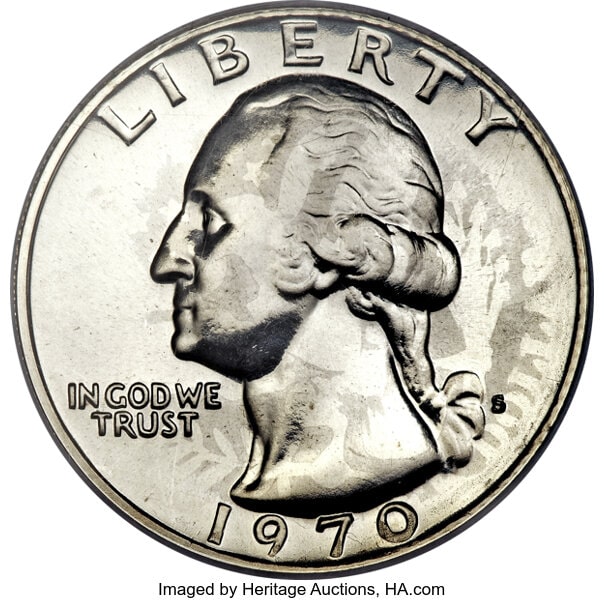

The one shown above is one of only two known specimens.
This mint error was uncovered among a group of San Francisco Proof Errors auctioned by the State of California. Uniquely, both sides of the coin display details from the original Barber Quarter design.
Given the improbability of true minting mistakes, experts from the coin-collecting community believe this piece was an intentional error.
This coin is one of the most famous U.S. Proof Major Mint Errors ever released from the San Francisco Mint, and it is valued at approximately $75,000.
If you wonder what other quarters are silver, check here
1970-D Quarter Struck On Dime Stock

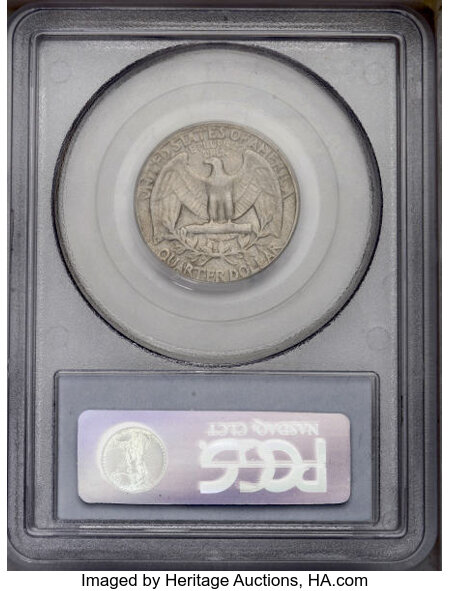
Often called "thin quarters," The 1970 D Washington Quarters were struck on dime-thick stock.
In 1970, someone fed a strip of metal meant for dimes through the stamping machine that creates Quarter blanks. Though they do share the same base metal composition, quarters are significantly larger and heavier than dimes. A quarter weighs 5.67 grams with a diameter of 24.3 millimeters. A 1970 Roosevelt dime weighs 2.27 grams and has a diameter of only 17.9 millimeters.
Therefore, using the dime stock to create quarter blanks resulted in a much thinner planchet. Subsequently, the blanks were fed into coining presses to create the actual coins, creating the above-mentioned “Thin Quarters.”
They can be worth hundreds of dollars (around $100) in the open market with no standard value.
Conclusion
In this article, we discussed the main factors that affected the 1970 quarter value, including the condition of the coins, rarity, error coins, and varieties.
As you saw, the 1970 Washington Quarter is scarcer in uncirculated examples and reaches premium prices as the grade increases. When comparing issues from Philadelphia and Denver mints, coins from the Denver facility are more common, making them easier to find in Superb Gem grades, although they are still quite rare.
Proof coins from the San Francisco Mint tend to fetch higher prices when in Deep Cameo tones, as this condition highlights the design details of the coin, making them more eye-appealing.
FAQs
Why is a 1970 quarter worth $35000?
The 1970-S Proof Quarter from the United States was overstruck on a 1941 Canadian Quarter, displaying significant detail from the original design. This fascinating mint error was initially offered for $35,000, but, in the open market, the value surpasses $40,000.
What makes a 1970 quarter rare?
The most famous and expensive coin from the series is the 1970-S quarter, struck from an 80% silver 1941 Canadian quarter and appraised at $40,000. A Canadian dime got into the quarter coining press. Quarters are supposed to be made of copper-nickel, but this one is silver. Graded PF65 by the NGC, this unique coin is owned by error coin specialist Mike Byers.
How much is a 1970 quarter worth today?
As of June 2024, a 1970 quarter can be worth up to $2,750 for Philadelphia issues in MS67+ and up to $10,000 for Denver issues in MS68+. The error double die obverse coins from the Denver Facility are worth 3,000 in MS-65 condition, and the double die reverse variety of this error can fetch 650 in MS-67. The most famous 1970 quarter, a 1970-S struck on a 1941 Canadian quarter, sold for $40,000.
What 1970 coins are worth money?
Philadelphia issues of the 1970 Washington quarter in MS67+ can fetch up to $2,750, while Denver issues in MS68+ can reach $10,000, according to the Professional Coin Grading Services price guide as of September 2025.








